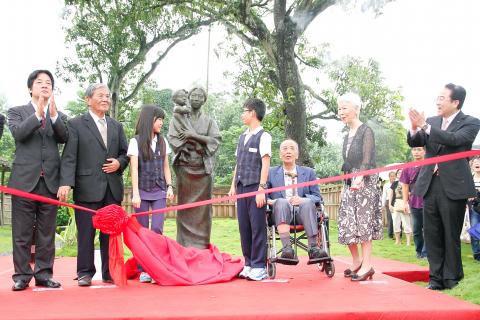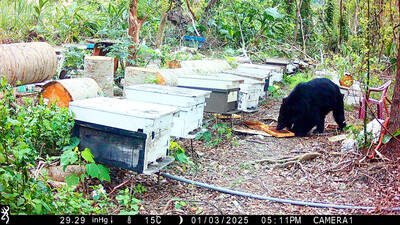More than 300 dignitaries and guests gathered in Greater Tainan on Sunday to commemorate Japanese civil engineer Yoichi Hatta and his wife, Toyoki Yonemura, for their dedication and contribution to Taiwan’s economy and agricultural development.
The event was held at the Yoichi Hatta Memorial Park(八田與一紀念園區) at the Wushanto Reservoir (烏山頭水庫), one of the projects designed and built by Hatta during his 32 years of service in Taiwan from 1910 to 1942. A large Japanese delegation also attended the event, including Hatta’s daughter-in-law, Ayako, and other family members.
Greater Tainan Mayor William Lai (賴清德) unveiled a bronze statue of Yonemura, a commissioned artwork by Yoshiki Murai.

Photo: CNA
Organizers said the statue gives a full rendering of the couple’s moving life story, with Yonemura as a virtuous woman and a loving wife, providing a resolute supporting force to her husband.
“Hatta made great contributions to Taiwan with his construction of irrigation networks and water reservoirs. Farmers’ lives and agricultural development benefited enormously from his engineering projects... He turned barren lands into productive granaries,” Lai said.
“He is also the link to the sister-city friendship between Greater Tainan and Kanazawa City, Hatta’s hometown,” the mayor said.
Hatta, also known among Taiwanese as the “Father of the Chianan Irrigation System (嘉南大圳),” was a civil engineering graduate from the then-Tokyo Imperial University (now the University of Tokyo) in 1910, and came to Taiwan that year.
Working for the Japanese colonial government at the time, Hatta was the chief engineer who designed and built a vast network of irrigation channels, measuring more than 16,000km in length, to cover more than 100,000 hectares of farmland around Chiayi and Tainan.
The project took 10 years and was completed in 1930. It raised the productivity of the southern plains, with annual harvests of 83,000 tonnes of rice, sugarcane and other crops, directly benefiting 600,000 farmers.
Hatta was killed in 1942, onboard a Japanese ship that was sunk in a submarine attack during World War II. He was on his way to Manila, where the Japanese government had sent him to develop agriculture in the Philippines.
His body was found, and after cremation, a portion of his ashes was taken to Taiwan for burial in a gravesite at the reservoir.
Local residents had built a statue for the Japanese engineer in 1931 to pay tribute to his contributions. However, they hid the statue for 40 years from 1941, fearing the Japanese government and later the Chinese Nationalist Party (KMT) government would want to melt down the statue for war materials and for political reasons.
Only when the political climate began to change in 1981 did local residents uncover the statue for reinstallation at the Wushanto Reservoir park.
Despite her sadness at her husband’s death in 1942, Yonemura remained in Taiwan with her children until the end of World War II.
Hatta and Yonemura raised two boys and six girls in their 32 years in Taiwan. When Japan surrendered in 1945, all Japanese citizens were ordered to return home, including all the Hatta children.
Yonemura committed suicide on Sept. 1, 1945, by jumping into the reservoir her husband had built. Before her death, Yonemura had told one of the family members that her life was devoted to her husband and she wanted to remain by her husband’s side, so both of them could remain in the area in spirit to protect the reservoir and the irrigation networks.

SHIPS, TRAINS AND AUTOMOBILES: The ministry has announced changes to varied transportation industries taking effect soon, with a number of effects for passengers Beginning next month, the post office is canceling signature upon delivery and written inquiry services for international registered small packets in accordance with the new policy of the Universal Postal Union, the Ministry of Transportation and Communications said yesterday. The new policy does not apply to packets that are to be delivered to China, the ministry said. Senders of international registered small packets would receive a NT$10 rebate on postage if the packets are sent from Jan. 1 to March 31, it added. The ministry said that three other policies are also scheduled to take effect next month. International cruise ship operators

NUMBERS IMBALANCE: More than 4 million Taiwanese have visited China this year, while only about half a million Chinese have visited here Beijing has yet to respond to Taiwan’s requests for negotiation over matters related to the recovery of cross-strait tourism, the Tourism Administration said yesterday. Taiwan’s tourism authority issued the statement after Chinese-language daily the China Times reported yesterday that the government’s policy of banning group tours to China does not stop Taiwanese from visiting the country. As of October, more than 4.2 million had traveled to China this year, exceeding last year. Beijing estimated the number of Taiwanese tourists in China could reach 4.5 million this year. By contrast, only 500,000 Chinese tourists are expected in Taiwan, the report said. The report

The Forestry and Nature Conservation Agency yesterday launched a gift box to market honey “certified by a Formosan black bear” in appreciation of a beekeeper’s amicable interaction with a honey-thieving bear. Beekeeper Chih Ming-chen (池明鎮) in January inspected his bee farm in Hualien County’s Jhuosi Township (卓溪) and found that more than 20 beehives had been destroyed and many hives were eaten, with bear droppings and paw prints near the destroyed hives, the agency said. Chih returned to the farm to move the remaining beehives away that evening when he encountered a Formosan black bear only 20m away, the agency said. The bear

Chinese embassy staffers attempted to interrupt an award ceremony of an international tea competition in France when the organizer introduced Taiwan and displayed the Republic of China flag, a Taiwanese tea farmer said in an interview published today. Hsieh Chung-lin (謝忠霖), chief executive of Juxin Tea Factory from Taichung's Lishan (梨山) area, on Dec. 2 attended the Teas of the World International Contest held at the Peruvian embassy in Paris. Hsieh was awarded a special prize for his Huagang Snow Source Tea by the nonprofit Agency for the Valorization of Agricultural Products (AVPA). During the ceremony, two Chinese embassy staffers in attendance